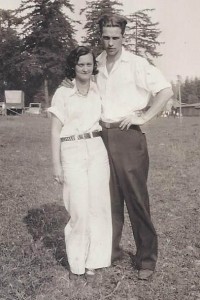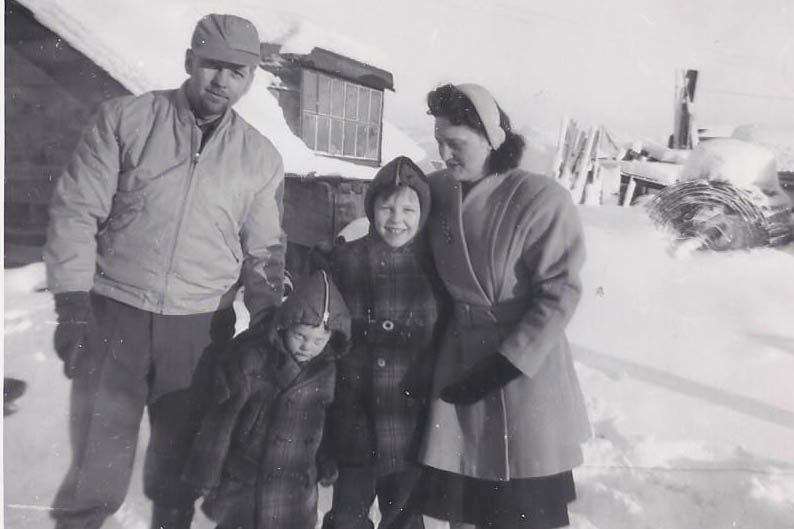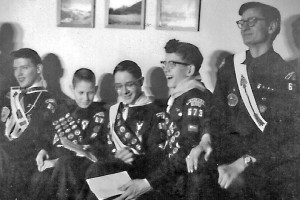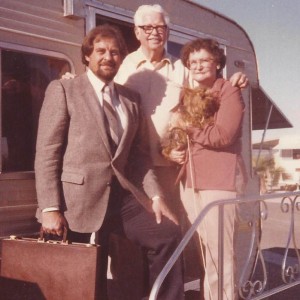Looking out the living room window of our duplex on Iliamna Drive I couldn’t have missed Ruby on her hands and knees furiously yanking from the flower bed my newly transplanted flowers. We were new to Alaska, having lived our first year on Government Hill and new to the neighborhood, Susitna View Park, just west of Turnagain-By-the-Sea subdivision, where Mel and Ruby lived. Their son, Norman, and I had become friends. The year was 1954.

Though we had raised chickens and rabbits and had planted a vegetable garden in Florida, there were no horticulturists in my family, and no knowledge of Alaskan flora. My dad and I had hauled shale rocks from along the Seward Highway, surrounded a small stand of birch in our front yard, and backfilled it with topsoil. I was assigned the task of providing the plants for the new flower garden, so I dutifully went into the woods nearby and dug up a number of fireweed, lupine and perhaps a stray delphinium or blue bell, the latter two of which would probably have been acceptable. The former two, especially fireweed, by any Alaskan’s definition are weeds, regardless of their beauty in the wild.
The weeds were being yanked out of the earth and replaced with pansies and assorted domesticated flowering plants. It was a kindly gesture in spite of its abrupt and pugnacious appearance, and we took it at face value—a seasoned Alaskan’s introduction to Alaskan Gardening 101. The job being completed, Ruby said something to me like, “What are you trying to do, kid, ruin the neighborhood?” She was noticeably worked up about the matter.
As a friend of Norm’s I had plenty occasions to visit the Rokeberg home, in fact, myself and other friends in the neighborhood, including Johnnie Tegstrom and Vaughn Cartwright, found any occasion an opportunity not to be passed up. Ruby, as well as being a knowledgeable gardener, was also of Danish extraction so, of course, she knew how to make Danish pastries.
Her husband, Mel, was also Scandinavian–but Norwegian–an electrical foreman who worked on large construction projects all over Alaska. Mel was born in Minnesota, grew up in Norway and worked hard to Americanize his speech, but he had a problem with pronouncing the letter “J” like most Norwegians. There were a number of Norske’ among Anchorage’s founding fathers, hence the absence, in the alphabetically arranged streets, of a “J” Street downtown between “I” and “K.”
Before our legions of bureaucrats had set up shop and begun to force-feed us a mind-boggling array of regulations–all of course for our own good–a person could prepare food in their own kitchen for commercial purposes, which Ruby did. She made Danish pastries and cookies in her kitchen that were served to passengers on Pacific Northern Airlines (later Western Airlines and then Delta Airlines) flights.
Most of the pastries Ruby made for Pacific Northern Airlines were of exceptional quality and appearance, but a small percentage of them were rejects. They might not have been good enough to sell to the airlines, but they were good enough for Norm, Johnnie, Vaughn and me, so we were regular visitors to the household, sort of like Pavlov’s dogs, only we didn’t have to hear the bell. We liked Norm too, but the pastries and cookies were the main attractions.
Ruby also baked the dessert tray of French and Danish pastries for the Garden of Eatin’, Anchorage’s leading restaurant in the 1950s and 1960s. The fact that the city’s finest restaurant was located in a Quonset hut in Spenard speaks volumes about the era. Lilla and I lived in a Quonset hut in Muldoon for a year after returning to Alaska in 1967.
For those who are unsure what a Quonset hut is; it was a ubiquitous Alaskan structure in Anchorage and elsewhere for at least twenty-five years after WWII. The United States Navy needed a lightweight building that could be shipped anywhere and assembled with unskilled labor. They were constructed of corrugated galvanized steel with a semicircular cross-section and could be erected on concrete or pilings, or just put right on the ground with a wooden floor. The name derives from the site of first manufacture, which was Quonset Point, at a Navy construction center in North Kingston, Rhode Island.
I remember one summer when I was probably still attending what we used to call junior high (today’s middle school) at Central Junior High, since razed to accommodate the Performing Arts Center, when Ruby took Norm, me, and Roger Harman, on a fishing trip to Hope, Alaska. We drove to Hope in the Rokeberg’s burgundy, 1950, Mercury.
Before the earthquake of 1964, there was a general store in Hope run by an elderly gentleman and he had everything under the sun in that place, stacked all the way up to the ceiling on either side of the several aisles, one of the many unique things missing after the quake that helped to define pre-earthquake Alaska from post-earthquake Alaska. But, it was still there years later, when my family and I used to spend summers in Hope camped along Resurrection Creek, my mother panning for gold while my dad and I, and others caught fish.
Growing up in Alaska in the 1950s I didn’t know a single person who fly-fished or practiced catch-and-release. We were harvesters and that’s the way I was raised. My idea of a fly was a chunk of lead with a big treble hook attached. We had a crawl space in our house on Iliamna Drive and the ground was a pretty good quality of sand.
I would take a Coleman burner down there, some wire, treble hooks, pieces of lead from wherever I could scrounge them and cut about a foot of the end of a broom or mop handle off. I’d melt the lead in a pan over the Coleman burner, wet the sand, poking the end of the handle an inch or two into it to make a mould. Then I’d pour the hot lead in, immediately inserting a twisted piece of coat hanger, sinking it in up to the eye with a pair of pliers. After it cooled the chunk of lead would be tied to the underside of a treble hook and I was good to go.
We had a grand time camping and snagging Humpies, but the return trip turned into a real adventure because the highway was washed out just beyond Indian. The road had been replaced by a torrential, brown, debris-filled stream, so we were stuck on the other side and there was nothing we could do but improvise until the road crews were able to make suitable repairs.
There was a log cabin on nearby Indian Creek, owned by a friend of Ruby and Mel’s who worked for the railroad, so we didn’t have to sleep in the car. We had plenty of fresh-caught fish to eat, a roof over our heads and a deck of cards, so it was a delightful sojourn. The fish we couldn’t eat didn’t fare so well due to a shortage of ice, resulting in a bumper crop of potatoes that year from the Humpy fertilizer.

Ruby doted on us kids, took an interest in what we were doing and did things with us. She was a sweetheart, though she was a little hard on Norman, who never seemed to be able to live up to her expectations. Ruby and Mel had lost their first son to polio. He was a senior in high school at the time of his death, seven years older than Norm, among the last polio deaths in Alaska, because the Salk vaccine was released a year later.
Ruby was never the same after the loss. Donnie had been exemplary—the perfect son. He hung up his clothes, whereas Norman was intransigent and a bit of a challenge and did not hang up his clothes, or put them in the hamper. Ruby couldn’t help spoiling him because of the loss of her eldest son, but she also couldn’t help nagging at him. He might have made it easier on himself had he kept his room more tidy, but he wasn’t so inclined and it was a regular flash point with Ruby, who cured the problem by refusing to wash his clothes until some were hung up and others found their way to the hamper.
Scouting was one activity that Norm and Johnnie and I became totally immersed in and committed to, all three achieving the rank of Eagle Scout. My dad, an Eagle Scout himself, was involved in the program as a member of the merit badge completion committee. Territorial Alaska was a perfect place for scouting activities. We didn’t take hikes or camp in a park; we did it in the authentic wilds. When we had a Winter Survival, it was the real deal. I remember once when a group of a dozen or so of us went on an overnight hike into Wolverine Lake and lost the trail on the way out. By the time we found the main road by following the stream flowing from the lake, where there was no trail and we had to “bushwack” our way, we were many hours late and the National Guard had been alerted.
One of the highlights of my scouting years is that the Black Panther Patrol, of which I was the patrol leader, was awarded the coveted Presidential Award for having the best campsite throughout the course of a Summer Camporee. Ruby made our patrol flag—a black panther on a field of red. I never got to attend a National Jamboree, but Mel and Ruby made sure that Norman got to attend one at Valley Forge, Pennsylvania. I was envious.
Our Boy Scout Troop 673, was sponsored by the Spenard Lions Club and we met in the North Star Elementary School until homesteader Chet Lampert allowed the club to put a Quonset hut on his property on the north shoreline of Blueberry Lake—now the northeast corner of Northern Lights Blvd and “A” Street. Eddie Peabody played his banjo for us in that Quonset hut and, clever boys that we were, we made up a little diddy about how Eddie “Playbody” had peed for us.

Mel was a mild-mannered, intelligent man with a slight Norwegian accent who also took an interest in us kids. The only time I went fishing on the Kenai River until I was middle-aged was when Mel took Norm and me to Bing’s Landing to fish for rainbow trout with the world famous Bing Brown, one of the early guides on the river who helped turn it into an international destination.
One day when I was maybe a sophomore in high school and Norm and Vaughn were freshmen, we were all practicing throwing a discus in the Rokeberg’s front yard. I somehow managed to throw it right through their living room window. I felt terrible about the incident and promised Mel and Ruby I would pay for the damages. It was a lot of money for a kid and I’m sure they thought I’d probably never keep my promise, but I saved up money from my paper route and paid back every cent. I know that meant a lot to them both, but Mel in particular, and it was no doubt part of the reason I was, in 1967, included when Mel put up $8,000 at 8% for Norm, Johnnie and me to invest in a business that ended up being the Bird House Bar.
When I was an adult, my mother admitted to me that Ruby was the only person in her life of whom she had ever been jealous. I said, “But why, mom?” She replied, “Because my son regularly came home carrying on about Ruby this and Ruby that!” There is no doubt she was tough competition, and Ruby was home all day, Mel frequently working out of town, while my mom taught school five days a week (and didn’t have those Danish baking skills.)
Norman has reminded me about one of Ruby’s favorite stories and an important event in her life. Like Mel, she was born in America, but returned to Denmark in the 1920s to spend her teenage years in Copenhagen working as a housemaid. Among her prized possessions was a small embroidered envelope that held a card upon which was printed (translated):
Miss Ruby
From the
USA
Dancing the Charleston
The card was distributed to the public for a dance exhibition that included Ruby introducing the most popular dance of the “Roaring 20’s,” the Charleston, to Denmark. She loved to dance and was known to drag unsuspecting males of all ages onto the dance floor.
Ruby’s love of dancing led to an interesting episode in the lives of Norman, Johnnie, myself and other members of the Black Panther Patrol, including perhaps Jack Griffith and Roger Harmon, when she coerced us into taking dancing lessons. We were adolescent Boy Scouts and had not the least interest in learning to dance. When the dreaded day arrived we were dragged to a dance studio on Spenard Road where the Tiki Lounge is now and introduced to two statuesque, tall, beautiful, blonde near-twin sisters, in their late 20s or early 30s, from Vienna.
Boy, did our attitudes change! Over the course of several months we learned to tango, waltz, foxtrot and rumba. I was pretty height-challenged at the time, being only an inch or two over five feet tall, so when I was held in a dancing embrace my face was staring into and smothered by a couple of humongous breasts. It was hard to keep my mind on my feet.
Once in the early 1980s, when The Saltry had only been open a year or two, Norm and his wife, Gayle, and Mel and Ruby came to visit us in Halibut Cove. Because of the small size of the restaurant then and the large size of the group, we had dinner upstairs and Marion Beck, the proprietress, waited on us herself. There was a very limited menu and most of the items on it were either “sushied,” “pokied,” or pickled, the fish having been caught by Marion’s husband, Dave.
Ruby had a fit. There was no alternative menu, sushi had not become popular in the America as yet, especially in the Alaskan outback, and it wouldn’t have mattered to Ruby if it had. She said, “Do you know about Pearl Harbor?” “Don’t you know who won the war?!” All the while, Mel was kicking her under the table and the rest of us stared in stunned silence. It was a button on Ruby I had never witnessed being pushed. Now I know that Marion has a temper, but she kept her cool, smiled and carried on admirably. It was quite a show, and we’ve laughed about it many times since.

Ruby not only made pastries, she also made cakes for weddings, birthdays and other occasions. She had not been able to make a wedding cake for my first marriage, which occurred in San Francisco, or my second, which had taken place in my log cabin on Sixth Avenue, but she was determined to make the cake for my marriage to Shelli. She called me several times and I kept mentioning it to Shelli. The cake wasn’t a big issue for Shelli, but it was for Ruby, who felt we needed a proper one.
She did make the cake, which was, at my request, a carrot cake that had to have cream cheese on it instead of frosting. The little sugar rosettes Ruby spent days patiently forming with her arthritic fingers and freezing in Tupper Ware containers, wouldn’t adhere properly to the cream cheese like they would have to regular butter cream frosting because it was soft, and the flowers tended to sag and fall off, so Ruby had to stand guard over the cake, butter knife in hand, surreptitiously slapping those rosettes back in place. There was never a more focused wedding cake attendant until it was time for it to be served.
It was a beautiful cake. Ruby had outdone herself, and I was so pleased that she was so pleased to have been involved. The cake was a great favorite at the reception and afterwards when the leftovers were put out in the Bartlett High School faculty lounge by my sister, Pat.
I took the time to visit Ruby after Mel had died and she was living in the Pioneer’s Home downtown. I also attended her funeral so I could say goodbye to her. There were two parents I remember that gave generously of their hearts and time to us kids when I was growing up. One was Mr. Snipes, the father of another schoolmate, Larry, a fellow Boy Scout, who I always addressed respectfully as Mr. Snipes, even into adulthood–the other was Ruby.
Find more stories like this on Growing Up Anchorage.
I was born in Ft. Pierce, Florida, moved to Alaska in 1953, graduated from Anchorage High School and earned a Bachelor's degree in Political Science with a Minor in Philosophy at the University of San Francisco. I played alto saxophone in the Anchorage High School band, as well as ice hockey through high school and as a freshman at the University of Alaska Fairbanks before moving on to USF. Incidentally, I completed the seventeen credits I needed to graduate from USF in the Spring of 2011, 48 years late and earning a 4.0 gpa for the semester!
I have been a member of the Anchorage City Council and Anchorage Borough Assembly before unification, twice a board member of the Alcoholic Beverage Control Board, State of Alaska, and twice its Chairman. I have been on many boards, including Boys and Girls Clubs of Alaska, Anchorage Opera, Anchorage Repertory Theatre, Anchorage Mental Health Association and Boys Scouts of America, Western Alaska Council. I am an active Rotarian and past president of Anchorage Downtown Rotary.
My interests are climbing, running, skiing, scuba diving, reading, writing, traveling and opera. I have climbed six of the seven highest mountains on each of the continents and made three attempts on the seventh, Mt. Everest, reaching 27,500 ft. at age 50. I have also run fifteen marathons, including the original run from Marathon to Athens.
I have a son, Michael, a daughter, Michele, and seven grandchildren by my first wife. My present wife and I will celebrate our 26th anniversary in September 2012.




